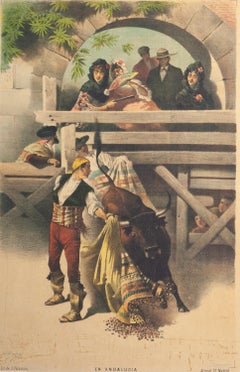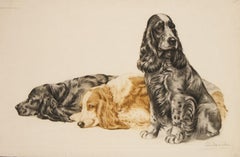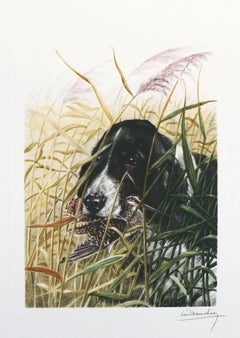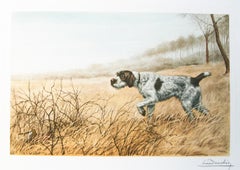Want more images or videos?
Request additional images or videos from the seller
1 of 8
Leon DanchinTwo Setters Resting by Leon Danchin20th c.
20th c.
Price:$750
About the Item
- Creator:Leon Danchin (1887 - 1938, French)
- Creation Year:20th c.
- Dimensions:Height: 19.25 in (48.9 cm)Width: 35 in (88.9 cm)
- Medium:
- Movement & Style:
- Period:
- Framing:Framing Options Available
- Condition:
- Gallery Location:Paonia, CO
- Reference Number:1stDibs: LU78037650612
About the Seller
4.9
Gold Seller
Premium sellers maintaining a 4.3+ rating and 24-hour response times
Established in 1978
1stDibs seller since 2017
128 sales on 1stDibs
Typical response time: 2 hours
Authenticity Guarantee
In the unlikely event there’s an issue with an item’s authenticity, contact us within 1 year for a full refund. DetailsMoney-Back Guarantee
If your item is not as described, is damaged in transit, or does not arrive, contact us within 7 days for a full refund. Details24-Hour Cancellation
You have a 24-hour grace period in which to reconsider your purchase, with no questions asked.Vetted Professional Sellers
Our world-class sellers must adhere to strict standards for service and quality, maintaining the integrity of our listings.Price-Match Guarantee
If you find that a seller listed the same item for a lower price elsewhere, we’ll match it.Trusted Global Delivery
Our best-in-class carrier network provides specialized shipping options worldwide, including custom delivery.You May Also Like
BACKLAND Signed Lithograph, Bucks County Landscape, Stone Farmhouse, Yellow Sky
By Peter Sculthorpe
Located in Union City, NJ
BACKLAND is an original hand drawn limited edition lithograph(not a photo reproduction or digital print) by the realist painter, Peter Sculthorpe (b.1948 Ontario, Canada) printed using hand lithography techniques on archival Arches paper, 100% acid free. BACKLAND is a finely detailed drawing of a Bucks County...
Category
1990s Realist Landscape Prints
Materials
Lithograph
$660 Sale Price
20% Off
H 19 in W 39.5 in
HILLTOPPER Signed Lithograph, Winter Landscape, Horse, Equestrian English Riding
By Peter Sculthorpe
Located in Union City, NJ
Hilltopper is an original, hand drawn, limited edition lithograph(not a photo reproductioon or digital print) by Peter Sculthorpe (b.1948 Ontario, Canada) printed using hand lithography techniques on archival Arches paper, 100% acid free. Hilltopper is a finely detailed winter landscape drawing depicting a snow covered hilltop with a lone, English style horseback rider and nature details including dried grasses, branches, and large bare tree firmly anchored to the frozen earth.
Print size - 32 x 27 inches, unframed, excellent condition, pencil signed by Peter Sculthorpe, inscribed PP#8(Printers Proof) aside from the edition of 275
Edition size - 275, plus proofs
Year published - 1989
Printer - J K Fine Art Editions Co. NY
Peter Sculthorpe's paintings are well known for their true to life depictions of rural stone barns, color changing shadowy skies, snow covered landscapes, cows, horses, lone figures that capture the countryside and stone architecture of the Brandywine Valley...
Category
1980s Realist Landscape Prints
Materials
Lithograph
$630 Sale Price
20% Off
H 32 in W 27 in
BUCK RUN BRIDGE Signed Lithograph Historic Covered Bridge Winter Landscape, Cows
By Peter Sculthorpe
Located in Union City, NJ
BUCK RUN BRIDGE is an original, hand drawn, limited edition lithograph(not a photo reproduction or digital print) by Peter Sculthorpe(b.1948 Ontario, Canada) printed in 1990 at JK Fine Art Editions Co. NYC, using hand lithography techniques on archival Arches paper, 100% acid free. Buck Run Bridge depicts a finely detailed drawing of a historic covered bridge in Chester County, Pennsylvania. BUCK RUN BRIDGE is an elongated horizontal composition, image measures 11.5 in. H x 36.75 in. W; a very appealing scenic Pennsylvania winter landscape with subtle details exhibiting fine line drawing and watercolor-like washes blending to form a wintry blue sky. The landscape captivating the viewer's eye with its delicate branches on bare trees, stone walls, split rail...
Category
1990s Realist Landscape Prints
Materials
Lithograph
$768 Sale Price
38% Off
H 17 in W 39 in
LITTLEWOODS Signed Lithograph, Historic Stone Farmhouse, Bucks County Landscape
By Peter Sculthorpe
Located in Union City, NJ
LITTLEWOODS is an original hand drawn, limited edition lithograph by Peter Sculthorpe (b.1948 Ontario, Canada) printed using hand lithography techniques on archival Arches paper, 100...
Category
1980s Realist Landscape Prints
Materials
Lithograph
$600 Sale Price
24% Off
H 27 in W 39 in
Frogs and Toad, Signed lithograph (AP), from Conspiracy: The Artist as Witness
By Jack Beal
Located in New York, NY
Jack Beal
Frogs and Toad, 1971
Hand signed in pencil by Jack Beal, annotated AP
One-color lithograph proofed by hand and pulled by machine from a zinc plate on Arches buff paper with deckled edges at the Shorewood Bank Street Atelier
Stamped, hand numbered AP, aside from the regular edition of 150 Stamped on reverse: COPYRIGHT © 1971 BY JACK BEAL, bears blind stamp
18 × 24 inches
Unframed
18 x 24 inches
Stamped on reverse: COPYRIGHT © 1971 BY JACK BEAL, bears distinctive blind stamp of publisher (shown) Publisher: David Godine, Center for Constitutional Rights, Washington, D.C.
Jack Beal's "Frogs and Toads" is a classic example of protest art from the early 1970s - the most influential era until today. This historic graphic was created for the legendary portfolio "CONSPIRACY: the Artist as Witness", to raise money for the legal defense of the Chicago 8 - a group of anti-Vietnam War activists indicted by President Nixon's Attorney General John Mitchell for conspiring to riot during the 1968 Democratic National Convention. (1968 was also the year Bobby Kennedy was killed and American casualties in Vietnam exceeded 30,000.) The eight demonstrators included Abbie Hoffman, Jerry Rubin, David Dellinger, Tom Hayden, Rennie Davis, John Froines, Lee Weiner, and Bobby Seale. (The eighth activist, Bobby Seale, was severed from the case and sentenced to four years for contempt after being handcuffed, shackled to a chair and gagged.) Although Abbie Hoffman would later joke that these radicals couldn't even agree on lunch, the jury convicted them of conspiracy, with one juror proclaiming the demonstrators "should have been shot down by the police." All of the convictions were ultimately overturned by the 7th Circuit Court of Appeals.
This lithograph has fine provenance: it comes directly from the original Portfolio: "Conspiracy The Artist as Witness" which also featured works by Alexander Calder, Nancy Spero and Leon Golub, Romare Bearden Sol Lewitt, Robert Morris, Claes Oldenburg, Larry Poons, Peter Saul, Raphael Soyer and Frank Stella - as well as this one by Jack Beal. It was originally housed in an elegant cloth case, accompanied by a colophon page. This is the first time since 1971 that this important work has been removed from the original portfolio case for sale. It is becoming increasingly scarce because so many from this edition are in the permanent collections of major museums and institutions worldwide.
Jack Beal wrote a special message about this work on the Portfolio's colophon page. It says, "In 1956, shortly after Sondra and I moved to New York, two friends were arrested and jailed for protesting air-raid drills. From them and their friends came our education. This work is dedicated to them and their families. "In Memory of Patricia McClure Daw and AL Uhrie" - This print was made for their children.
Jack Beal Biography:
Early in his career Walter Henry “Jack” Beal Jr. painted abstract expressionist canvases, because he believed it was “the only valid way to paint.” By the early 1960s he totally altered his approach and fully repudiated abstraction. Turning to representation, he painted narrative and figurative subjects, often enhanced by bright colors and dramatic perspectives.
Beal was born in Richmond, Virginia, and from 1950 to 1953 he attended the Norfolk Division of William and Mary College Polytechnic Institute, (now Old Dominion University) where he studied biology and anatomy. Shifting gears, he sought art training at the School of the Art Institute of Chicago where he focused on drawing, and met his wife, artist Sondra Freckelton. His art history instructor encouraged her students to paint in the manner of established artists, and to that end he frequented the Institute’s galleries. For Beal this was significant: “Until I saw pictures of real quality I had tended to think of painting as just so much self-indulgent smearing around, but when I saw masterpieces by Cézanne and Matisse, and other painters of similar stature, I was bowled over; suddenly I realized the force of art.”
After spending three years (1953–1956) at the Art Institute, Beal concluded his studies there without getting a terminal degree, thinking it was only useful if he wanted to teach, which, at the time, he did not. He also took courses at the University of Chicago in 1955 and 1956. During this period he married Freckelton, a fellow student and sculptor who began her career working in wood and plastic. Together they moved to New York’s SoHo District before its transformation from a wasteland of sweatshops and small factories into an arts district. They were active with the Artist Tenants Association which was instrumental in getting zoning laws changed so that artists could live and work in the well-lit lofts.
Embracing what came to be called “New Realism,” Beal initially painted an occasional landscape as well as earthy-toned still lifes which consisted of jumbled collections filled with personal objects. His signature style started with a series of female nudes—all modeled by Freckelton—based on Greek mythology. These were large canvases with flat paint surfaces, dramatic foreshortening, and unusual perspectives. He further enlivened them with vivid colors, stark lighting, and dynamic patterns derived from textiles and overstuffed furniture. He stopped painting nudes after two episodes. The first came as he was loading a canvas of his naked wife onto a truck in lower Manhattan; several laborers walked by and started to fondle and kiss the painting. On the one hand he felt his wife had been violated, while on the other he was pleased that his realism was so convincing. The second occurred after a solo exhibition in Chicago at which the reception had been sponsored by Playboy magazine. A few days later he was approached by a publicist and asked if Playboy bunnies could be photographed in front of his paintings. He refused.
Some portrait commissions came Beal’s way, but he preferred only portraying friends. More significant were four large murals on the History of Labor in America, the 20th Century: Technology (1975), which he undertook for the headquarters of the United States Department of Labor in Washington. Following a historical timeline, the themes were: colonization, settlement, nineteenth century industry, and twentieth century technology. The unveiling ceremony was attended by government officials and Joan Mondale, an arts advocate and wife of the vice-president. The reviewer for the Washington Post wrote enthusiastically: “They’re heartfelt and they’re big (each is 12 feet square). Their many costumed actors (the Indian, the trapper, the scientist, the hardhat, the capitalist in striped pants, the union maid, etc.) strike dramatic poses in dramatic settings (a seaside wood at dawn, an outdoor blacksmith’s forge, a 19th-century mill, a 20th-century lab). The lighting is theatrical. Beal’s compositions, with their swooping curves and bunched diagonals, are as complicated as his interwoven plots.” To accomplish the murals Beal assembled a team of assistants and models, much in the manner of Renaissance masters, which included artist friends and Freckelton. who by then was painting brightly colorful still lifes.
A second mural commission ensued from New York City’s Metropolitan Transit Authority for two twenty-foot long installations for the Times Square Interborough Rapid Transit Company subway station. Beal’s designs for The Return of Spring (installed in 2001, three days after the terrorist attacks in New York, Washington, DC and Philadelphia) and The Onset of Winter (installed in 2005), Beal captured the appearance of his models in an oil painting made to the scale of the intended mosaic. A collaboration with Miotto Mosaics, the canvases were shipped to the Travisanutto Workshop, in Spilimbergo, Italy, where craftsmen fabricated the design to glass mosaics. The Return of Spring depicted construction workers and other New Yorkers in front of a subway kiosk and an outdoor produce market and in The Onset of Winter, a crowd watches a film crew recording a woman entering the subway as snow falls against the city’s skyline. Harkening back to some of his early nudes based on Greek myth, Persephone, goddess of fertility and wife of Hades, appears in both. The symbolism is pertinent, since she spent six months each year below ground.
Although he disparaged teaching early on, Beal and Freckelton offered four summertime workshops on their farm in Oneonta, New York. He was an instructor at the New York Academy of Art, a graduate art school he helped to establish in 1982. Returning to Virginia, he taught at Hollins College...
Category
1970s Realist Animal Prints
Materials
Lithograph
Great White Shark, Lithograph by Richard Ellis
Located in Long Island City, NY
Great White Shark
Richard Ellis, American (1938)
Date: circa 1979
Lithograph, signed and numbered in pencil
Edition of 500
Image Size: 18 x 25 inches
Size:...
Category
1970s Realist Animal Prints
Materials
Lithograph
Fine and well-preserved lithograph with ornithological subject by John Gould
By John Gould
Located in Milan, IT
Original hand-watercoloured lithograph also signed in plate by publisher C. Hallmandel; C. E. Jackson, "Dictionary of Bird artists of the world", Woodbridge, Suffolk 1999, pp. 259-26...
Category
1830s Realist Animal Prints
Materials
Lithograph
$341
H 21.26 in W 14.18 in
Banana Grove
By George Biddle
Located in New York, NY
George Biddle (1885-1973), Banana Grove, lithograph, 1928. Signed, titled and numbered in pencil [also annotated in the plate “Biddle/1928, lower right “47). References: Pennigar 81, Trotter 47. In excellent condition, the full sheet, on cream wove BFK RIVES paper, with their (partial) watermark. 12 1/2 x 9, the sheet 20 x 16, archival mounting (non attached mylar hinging between acid free board, glassine cover).
A fine fresh rich impression in pristine condition.
After Groton, Harvard College...
Category
1920s Realist Animal Prints
Materials
Lithograph
Goat Herder's Wife
By George Biddle
Located in New York, NY
George Biddle (1885-1973), Goat Herder’s Wife, 1928, lithograph, signed in pencil lower right and titled and numbered (64/100) in pencil lower left margin [with the inscription ”Bidd...
Category
1920s Realist Animal Prints
Materials
Lithograph
Leucippus Fallax (Buffy Hummingbird) — Original Hand-colored Lithograph
By John Gould and Henry Constantine Richter
Located in Myrtle Beach, SC
John Gould, 'Leucippus Fallax' (Buffy Hummingbird), original lithograph with hand-coloring (not a reproduction), c. 1850. Signed in typeset 'J. Gould and H. C. Richter, del et lith.'...
Category
1850s Realist Animal Prints
Materials
Lithograph
More From This Seller
View AllFive images from the popular 1886 Spanish Bullfighting Journal La Lidia
Located in Paonia, CO
La Lidia, the oldest and most popular bullfighting magazine was founded by Julian Palacios the owner of a prestigious lithograph and engraving workshop in Madrid. These colorful...
Category
1880s Realist Figurative Prints
Materials
Lithograph
Three Cocker Spaniels original signed etching by Leon Danchin
By Leon Danchin
Located in Paonia, CO
Three Cocker Spaniels is an original color etching by well known French sports artist Leon Danchin. The three Spaniels are in waiting mode with two lying down and one sitting ...
Category
1930s Realist Animal Prints
Materials
Etching
Dog and Snipe original signed limited edition etching by Leon Danchin
By Leon Danchin
Located in Paonia, CO
Leon Danchin, born in Lille, France in 1887 began his career as an artist at the age of sixteen when he was accepted by the Salon des Artists in Paris. He eventually became known as ...
Category
20th Century Realist Animal Prints
Materials
Etching
Griffon With Woodcock original signed etching by Leon Danchin
By Leon Danchin
Located in Paonia, CO
Griffon With Woodcock is an original etching by Leon Danchin showing a Griffon in a field pointing at a Woodcock trying to hide in the brush. This color etching is in good conditi...
Category
20th Century Realist Animal Prints
Materials
Etching
Red Breasted Merganser from Illustrations of British Ornithology Pl.58 by Selby
Located in Paonia, CO
Red Breasted Merganser PL 58 from a rare black and white edition of Prideaux John Selby’s two volume set of 222 engravings “Illustrations of British Ornithology”. These original...
Category
Mid-19th Century Realist Animal Prints
Materials
Engraving
Spaniel with Duck original signed etching by Leon Danchin
By Leon Danchin
Located in Paonia, CO
Spaniel With Duck is an original signed etching by Leon Danchin in very good condition.
paper size 22.25 x 30 image size 16.50 x 24
Leon Danchin, born in Lille, Fra...
Category
1930s Realist Animal Prints
Materials
Etching
$760 Sale Price
20% Off
Recently Viewed
View AllMore Ways To Browse
Horse Hunting Prints
Johann Leonhard Frisch
Kip Gresham
Larry Rivers Camel
Leroy Neiman Elephant
Lloyd Kiva
Lobster Telephone
Norbertine Bresslern Roth
Owl Woodblock Print
Picasso Bird Lithograph
Picasso Bull Plate
Picasso Chien
Picasso Dove Lithograph
Picasso Lithograph Gold
Picasso Lithograph Owl
Picasso Print Dove
Poster Aesthetic Vintage Art
Prairie Dog



